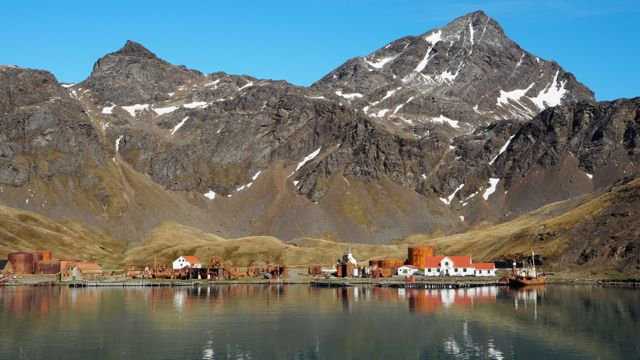We awoke this morning to another crystal clear day. Overnight we had relocated to King Edward Cove, at the head of which lies the abandoned whaling station of Grytviken. This is the only abandoned whaling station on the island that may be visited. It has been cleansed of hazardous materials and the fabric of the buildings has been stabilized.
It is, however, most notable as the site of a small whalers graveyard in which the remains of Ernest Shackleton and his right hand man, Frank Wild lie.
We left the ship early and motored across to the graveyard where we paid our respects to “The Boss.” Our expedition leader Doug proposed the traditional whisky toast and we splashed the dregs on Shackleton’s gravestones. This site is more adequately considered to be a shrine to the memory of Sir Ernest than a mere resting place for his remains and many make the pilgrimage to Grytviken especially to honour the great man.
We were then free to either take a natural history hike, a historic tour of the whaling station remains or, a self guided tour of the remnants of the works. There is a small but excellent museum that displays some Shackleton memorabilia and many artefacts related to the whaling industry and life at Grytviken. One collection also displays and interprets the natural history of the island, with many of the pelagic birds on display as well as fish and other aquatic invertebrates. A gift shop stocked with many tasteful items of apparel and jewelry did a brisk trade as guests snared Christmas gifts, small treasures and postcards that could be sent from the nearby Post Office. The rear of the post office is blessed with an exceptional display of original lantern slides by Frank Hurley, Shackleton’s photographic artist on the Endurance expedition. These lantern slides are on loan from the Royal Geographic Society in London.
The whaler’s church is nicely restored and offered a spot for those that sought a peaceful moment of quiet contemplation. Others tried their skill with the church bell pull ropes. In a nearby building a very nice replica of Shackleton’s life boat, the James Caird is the centerpiece of displays on the life and exploits of Sir Ernest. Some guests basked in the gorgeous sunlight after taking in the delights of this small settlement.
We returned to the ship and relocated to Fortuna Bay for the afternoon activity. This bay is the starting point for an overland walk that follows the final few miles of the intrepid journey from south to north across the island by Shackleton, Frank Worsley and Tom Crean after their epic journey from Elephant Island in the “Caird.” Many guests took on the challenge of the trek over the 1000’ saddle across scree slopes and through boggy terrain in some parts. It was a virtuous enterprise and the spectacular scenery was its own reward. We imagined the moment when the trio heard the steam whistle calling the men to morning work at the whaling station and relived the structures of the station coming into view as we crested the last rise.
It had been a long and somewhat exhausting day but all guests were content, having enjoyed the iconic location.







